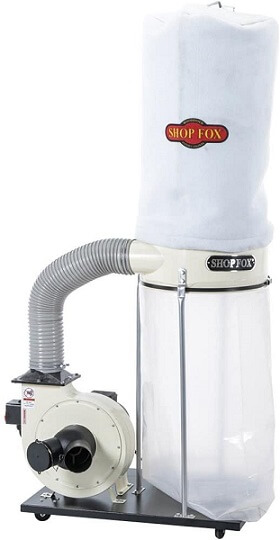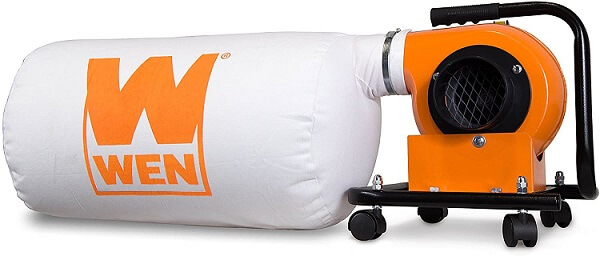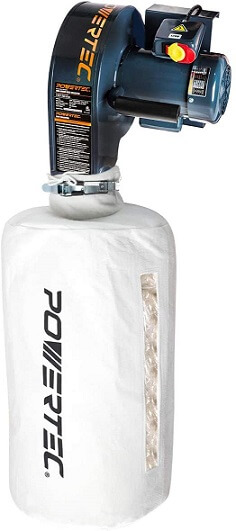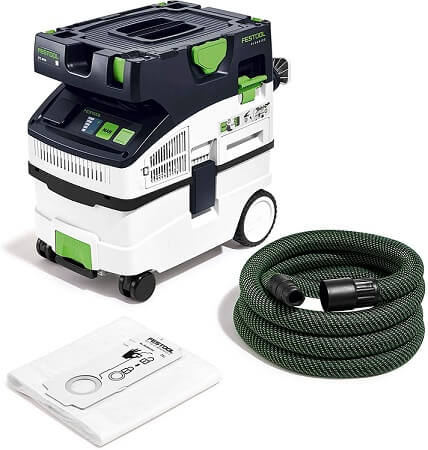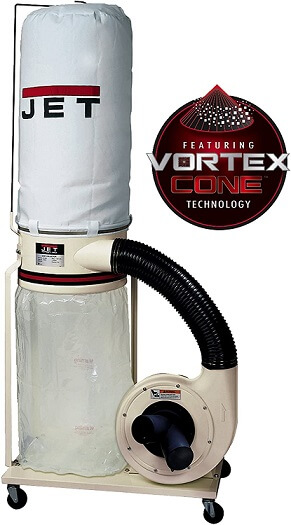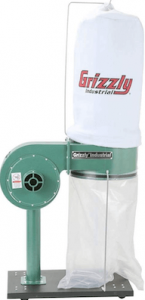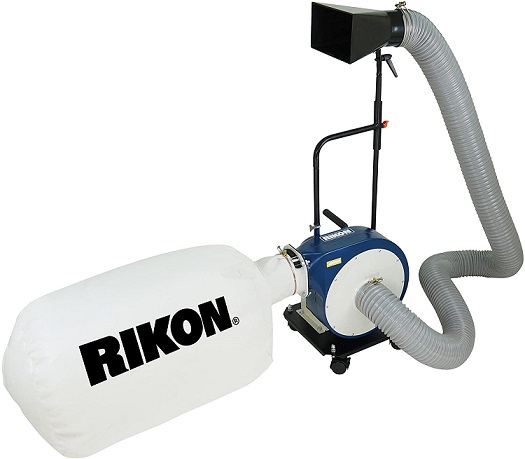“Maintain your workspace clean and less messy while working on the tasks with Dust collector”
Be it metal, carpentry or any other mechanical work, the common thing is the amount of saw dust or mess creating while cutting, grinding or sanding them.
Dust collectors are the best answers to deal with this issue. They suck out the all the debris so that you can work without any issues.
Apart from reducing the cleaning time, it will let you breathe as the waste from these works can be pretty harmful and pose respiratory issues.
Before investing, we suggest you consider the following key factors to find your ideal dust collector.
1. Motor Power: Dust collectors are driven by motors, and their power is measured in horsepower (HP). A powerful motor will offer a higher air suction capacity and determines a powerful and efficient performance. Usually, dust collectors having motor power within 0.5 – 1.5 HP is used for general purposes. While, some high-end models have motor power of more than 3HP.
2. Airflow Capacity: The airflow capacity is measured in cubic feet per minute (CFM), in which the higher the CFM, the quicker and efficient a dust collector will catch and remove the dust.
- The suction ability of a dust collector for dust extractors and shop vacs will be 100 – 150 CFM.
- A collector with 500 CFM or more will help to keep a clean work area while using small to medium-sized machines.
- A dust collector requires 1000 CFM (or more) to have enough suction power to use on multiple tools at a time.
3. Bag Capacity: It is defined as the amount of dust a bag or canister can hold easily. However, the dust collected regularly and the frequency of emptying the bag is essential to consider. A small workshop uses small bags/canisters that have to be emptied regularly, while large workshops use a bag with a minimum of 5 cubic feet capacity.
Besides these 3 key factors, there are so many things to consider like the amount of dust produced, workspace area, or type of collectors, which we mentioned everything in the detailed “Buying Guide”. To simplify your research, we came up with a list of best-selling dust collectors. Read on to know how to pick the right one, as per your requirement.
Best Dust Collector
| Dust Collector | Power rating | Air suction capacity | Warranty | Buy Now |
|---|---|---|---|---|
| Shop Fox Dust Collector | 10 amp | 1280 cfm | 2 years | Check On Amazon |
| Wen Dust Collector | 5.7 amp | 660 cfm | 2 years | Check On Amazon |
| POWERTEC Dust Collector | 7 amp | 537 cfm | 1 year | Check On Amazon |
| Festool Dust Extractor | 10 amp | 130 cfm | 3 years | Check On Amazon |
| Jet Dust Collector | 5 amp | - | 5 years | Check On Amazon |
| Grizzly Dust Collector | 8 amp | 500 cfm | 1 year | Check On Amazon |
| RIKON Dust Collector | 6.5 amp | 650 cfm | 5 years | Check On Amazon |
7 Best Dust Collector Reviews
1. Shop Fox Dust Collector
Shop Fox is a well-known brand that delivers many durable products. They also make a dust collector that we have mentioned here.
In the 1st position, we have a dust collector from Shop Fx. The W1685 dust collector has a 10 amp motor that runs at 3450 rpm. Therefore, it can maintain the airflow around 1280 cfm. Compared to other dust collectors, this airflow capacity is significantly better. As for the inlet, it has a “Y” shaped fitting that consists of 2 4-inches openings. The impeller size on this dust collector is 12 inches.
There is a safety switch on W1685 that will prevent accidental turn on. As of the filter, it has a 2.5 microns standard bag that is necessary for dust collectors. The overall weight of this machine is 108 lbs, which is moderate in the case of dust collectors. The warranty period on W1685 is 2 years, which is quite decent.
Best Features
- 10 amp motor
- 3450 motor rpm
- 1280 cfm airflow capacity
- “Y” shaped inlet
- 4 inches opening for inlet
- 12 inches impeller
- Safety switch
- 5-micron dust collection bag
- 108 lbs in weight
- 2 years of warranty
Pros
- Long warranty period
- Airflow capacity is great
Cons
- A bit heavier than other options
- Refills are expensive#2) WEN 3401 5.7-Amp 660 CFM Dust Collector with 12-Gallon Bag and Optional Wall Mount
2. Wen Dust Collector
Next up, we have a dust collector from Wen. Wen is a lesser-known brand that produces many affordable products like this dust collector.
We have selected Wen 3401 as our 2nd nomination for the best dust collector. Now, you can keep your garage clean with this 12-gallon dust collector. It houses a 5.7 amp motor that can allow it to absorb 660 cubic feet of air under a minute. The impeller size on this one is 6 inches, and the dust inlet ports are 4 inches wide. It also has a 1 ¾ inches caster lock that prevents unexpected operation.
As Wen is known for their reliability, they are providing 2 years of warranty on Wen 3401 dust collector. It is a very lightweight dust collector as it weighs only 18.6 lbs. Therefore, this can be the best option for you if you are looking for a transportable dust collector. You can also mount this machine on a wall with the help of a built-in wall mounting option. This way, you can keep your workspace free.
Best Features
- 7 amp motor
- 12-gallon capacity
- 660 cfm airflow capacity
- 4 inches opening for inlet
- 6 inches impeller
- 1 ¾ inch caster lock
- 6 lbs in weight
- 2 years of warranty
Pros
- Wall mounting option available
- Affordable price tag
Cons
- Airflow capacity is low
- Comparatively weaker motor
3. POWERTEC Dust Collector
You must have heard about Powertec as they are quite popular for their affordable products. They make various high rated products, including this dust collector.
At the 3rd position in our best dust collectors list, we have enlisted Powertec DC5370. It has many positive features that make it one of the best options from the market. Unlike many other dust collectors, you have the option to collect dust from the wall instead of the floor with DC5370. It is powered by a 7 amp motor that runs at a minimum of 120-volt input. It can provide 537 cfm airflow capacity that is good enough for home applications
It comes with a 2.5-micron standard dust bag having a transparent visual indicator. Because of this, you can easily keep a track of filter quality and clean whenever required. It is a very compact dust collector that weighs only 44.2 lbs that makes it easier for transportation as well as installation. You will get a 1 year warranty period on Powertec DC5370.
Best Features
- Wall dust collector
- 7 amp motor
- 120-volt input
- 537 cfm airflow capacity
- 5-micron transparent window bag
- 2 lbs in weight
- 1 year of warranty
Pros
- Wall cleaning possible
- Visual indicator for the dust bag
Cons
- Airflow capacity is quite low
- The warranty period is comparatively less
4. Festool Dust Extractor
Festool is rather a fresh brand that has quite a positive response from their customers. They make a lot of high rated power equipment, including this dust collector.
Festool 574837 is probably the most unique and advanced dust collector from our list. This is a bulky dust collector that is still easy to carry around because of its large-sized wheels. There are quite a few advanced features like Bluetooth connectivity, remote control, touch operation, etc. that will make it a perfect dust collector for your home.
It has an 11 ½ foot long hose that can be used to collect dust from even distant locations from the machine. You can adjust the speed of operation with the help of a speed adjustment dial. Even with the big form factor, it only weighs 19.2 lbs that make it the most lightweight option from our list. It houses a 10 amp motor that will provide you 130 cfm of air suction capacity. The container available in this collector has a 3.9-gallon capacity. Festool 574837 is backed by a long 3 years of the warranty period.
Best Features
- 10 amp motor
- 130 cfm airflow capacity
- 9-gallon container capacity
- 11 ½ foot long hose
- Speed adjustment dial
- Remote Bluetooth control
- Touch operation
- Safety features available
- 2 lbs in weight
- 3 years of warranty
Pros
- Long warranty period
- Lightweight dust collector
Cons
- Very expensive price tag
- Air suction capacity is low
5. Jet Dust Collector
Jet is a reliable brand that makes many durable power appliances. Along with many other products, they make a reliable dust collector too.
Jet DC-1100VX-5m is the most reliable option from our picks of best dust collectors as it comes with a long 5 years of the warranty period. Therefore, you can get free repairs for damages or even replacement in case of faulty parts for 5 years after the purchase. It has a 5 amp 115-volt motor that can provide considerable air suction capacity. The motor has a built-in cooling system that will prevent it from overheating.
As it weighs only 8 lbs, it is one of the most lightweight options from our list. Therefore, it’s quite easy to move it all around the house or workplace. The suction bag that comes with this dust collector is 5 microns that is thicker than other options. The unique feature of this dust collector is the vortex cone technology that allows better cleaning.
Best Features
- 5 amp motor
- 115-volt input
- Built-in motor cooling system
- Safety switch
- 5-micron bag
- 8 lbs in weight
- Vortex cone technology
- 5 years of warranty
Pros
- Long warranty period
- Vortex technology for better cleaning
Cons
- Airflow capacity is not mentioned
- Bit noisier than other dust collectors
6. Grizzly Dust Collector
Grizzly is yet another brand that is known for its heavy-duty products. They make a lot of professional powered tools, including this dust collector.
Grizzly Industrial G8027 is the most powerful dust collector from our list of best dust collectors. It has a 8 amp powerful motor. With this powerful motor, Grizzly Industrial G8027 is capable of a massive 500 cfm air suction capacity. With this much power, you can rest assured that your workplace will be completely cleaned. It also has a 4 inches wide “Y” shaped inlet that has two different 1 inches openings.
The impeller size on this dust collector is 9 inches, and the dust bag capacity is 2 cubic feet. The bag is a standard 30-micron bag that is essential for dust collection. As expected, this heavy-duty dust collector packs a lot of weight. It weighs 56 lbs that make it difficult for transportation and installation. With Grizzly Industrial G8027, you will get only 1 year of warranty period that is lower than many other dust collectors.
Best Features
- 8amp motor
- 500 cfm airflow capacity
- 4 inches“Y” shaped inlet
- 9 inches impeller
- 30-micron bag
- 56 lbs in weight
- 1 year of warranty
Pros
- Powerful motor
- Airflow capacity is best in class
Cons
- Warranty period is short
- Heavy dust collector
7. RIKON Dust Collector
RIKON is a reliable brand providing a wide range of power tools at an affordable price range.
Their dust collector has a small and convenient size which makes it suitable for small shops. In addition to that, compact size provides the versatility to install this unit anywhere you want without any issues.
It has the ability to collect up to 2.1 cubic meters of debris. So, you don’t have to stop frequently to discard the waste collected. As it comes with wheels, you can easily transport it from one place to another without any additional help.
It can filter dust particles up to 2 microns. This product comes with 5-year warranty duration.
Best Features:
- Suitable for small shops
- Quiet operation
- Compatible with 4” dust ports
- 9 bladed steel impellers
- 650 cfm
- 2 microns filter
- 5-year warranty
Pros:
- Easy to use
- Versatile mounting
Cons:
- Customer service not good
Buying Guide For The Best Dust Collector
One should know what factors to check and how to choose their best product. For your reference, we are here with a detailed guide to know all about dust collectors. There are so many aspects that have to be taken into account while shopping for a dust collector. They are used for the safety and convenience to work in your workshop.
Here is an outline of the list of factors to consider before buying.
1. Types
Based on the power, portability, and dust collection capacity, there are several types of dust collectors available – standard shop vacuums, cyclonic dust collectors, dust extractors, canister dust collectors, or bag dust collectors. Let’s get into its details.
a. Shop Vacuum Dust Collectors
Attach this shop vacuum hoses directly to dust collection outlets on power tools/machinery, which you are using. It is an affordable option, and this system is geared to smaller tools, yet won’t fit perfectly for a small storefront. Usually, you have to move the vacuum and hoses while switching the tools. Its main downsides include filling of collection tank and quick clogging.
b. Dust Separators
The dust separators act as an add-on that allow a shop vacuum work better. They remove heavy chips from the workspace with their cyclonic air movement, which move only fine dust back upstream to the vacuum. However, adding a dust separator to the device will help a lot in improving the dust collection suction and thereby reduces clogging.
c. Dust Extractors
These are specialized shop vacuum types that getting popular as standalone units, which are designed to use only with small hand tools. They work with the main purpose of collecting dust from only hand tool.
d. Single-Stage Bag Dust Collectors
It has a simple design and higher power output (larger HP) that let you connect to various tools. All these features will make it ideal to use for small but busy workshops. They are available in classic upright, wall-mount or handheld portable designs.
e. Canister Dust Collectors
Works the same as bag dust collectors in terms of connecting to multiple tools. However, a single-stage system will deflates and inflates, yet a cartridge type is fixed and has a grooved fin design that provides a great surface area to filter dust. Thus, it is good at capturing 1-micron & 2-micron dust particles effectively.
f. Cyclonic Dust Collectors
They feature higher CFM (airflow) and two-stage dust separation, which makes it the best option to use for industrial/large scale purposes. These are larger units yet can shrink down to fit for various larger workshops. They separate smaller dust particles from large debris. Here the larger pieces fall into a central collection chamber, while smaller particles get pulled through a fine filter to help capture dust into a smaller bag.
2. Size of Workshop
It is a must to consider the size of the workshop before purchasing a dust collector based on power. However, dust extractors and standard shop vacuums are small and portable, which makes them easy to use in any workshop. Yet they are ineffective for a workshop having multiple users, why because they let you connect only to a single tool at a time.
While canister and bag dust collectors are perfect options to use in large workshops, as they are set up in a central location to remove dust from various tools at a time. Yet they won’t fit for smaller workshops, why because they occupy too much floor space and thereby make the room congested for your work.
A wall-mounted bag dust collector is the perfect option for a small yet busy workshop, as they won’t take up any floor space but allow you to connect more than one tool for collecting dust effectively.
3. Inlet Size
You need to ensure that a dust collector you are buying will accommodate all your woodworking machines effectively. For this, you have to check on the inlet sizes and quantities of the unit.
However, standard inlet size on a dust collector will start from 4 – 8 inches (or more). Usually, the bigger the machine, the wider the inlet diameter is needed.
While working with basic machines on a small scale, then you need a single or dual inlet system with 4 – 6 inches wide. If dealing with multiple machines of different sizes, then pick a dust collector having multiple inlets of various diameters that let you work effectively.
4. Dust Collection Capacity
The amount of dust collected regularly and the frequency to empty the dust collector are two deciding factors while choosing a dust collector. Since, they are designed to collect dust, in which the canister or bag can easily hold a certain amount of debris. This is termed as dust collection capacity of a given dust collector unit.
For large workshops where a high amount of dust and debris is produced regularly, it is perfect to use a dust collector having at least 5 cubic feet of dust collection capacity. While smaller workshops or hand tools will use smaller canisters or bags, which they have to empty frequently whenever filled with dust. So, based on your workspace or using tools, you have to choose this collector bag with enough dust collection capacity.
5. Motor Power
Dust collectors are driven by their motors, which means you have to check the power rating of the motor before purchasing. A powerful motor can provide a higher air suction capacity required for continuous heavy usage of the dust collector. The motor power is measured in horsepower (HP), in which dust collector motors will range from 0.5HP to 3HP (or more).
6. Air Suction Capacity
The volume of air a dust collector remove is measured in cubic feet per minute (CFM). It represents how much cubic feet of air will be absorbed by the collector in a minute. Dust collectors with a higher rate of suction (CFM) will quickly catch the dust and clean up the area effectively.
For dust extractors and shop vacs, you should pick a dust collector with an air volume of 100 – 150 CFM, yet naturally, a dust collector should have 400 – 500 CFM for proper functioning. For busy workshops with bigger machines or heavy-duty projects, you need a dust collector with an airflow power rating of 1000 CFM or more to deliver suction power for clearing multiple tools at a time.
Pick a dust collector with enough CFM to capture dust and debris at a required capacity till the time you complete your work.
7. Fixed or Portable Dust Collectors
Portability is one of the deciding factors to check while buying a dust collector. The dust collectors are designed to either be a portable tool (lighter to carry or has a wheeled base to move it around) or fixed (mounted on the wall to save space).
a. Portable Dust Collectors : These can be moved around the workshop (or) from one tool to another easily. This makes them the best option for small to medium-sized workshops. These are available in various sizes and price ranges, which let you choose your ideal type for the working area.
b. Fixed Dust Collectors: These are large, heavyweight and powerful, which makes them the best option for large workshops, producing a lot of dust regularly. Also, it needs some professional assistance for its installation (includes installation charges) on the wall. The longer the hose, the lesser the suction power of the collector. So, prefer to mount the collector in a center space to make it use around.
8. Dust Volume
The amount of dust produced in your workspace is essential to consider while shopping for a dust collector. However, the volume of the dust produced will depend mainly on the machinery and tools you use most frequently.
For instance, if your project has to deal with a lot of sanding and sawing, then it generates lots of dust in the work area. Here, you require a two-stage cyclone dust collector instead of a single-stage filtration system, which is not enough to collect those heavily created dust.
9. Filter Efficiency
It indicates the capability of a filter in a collector to prevent dust, debris, and other impurities to pass through them. Thus, large dust particles which trap in the filter will allow the collector to perform at a high suction power with no clogs. This efficiency of a filter is measured by the absolute micron rating, which indicates the least size of particles a filter can easily capture.
Usually, the woodworking power tools will make extreme noise, which we can’t avoid this situation. But most of the craftsmen look for the maximum possible quietest tool with a decent performance. The noise level is measured in terms of decibels (dB), in which the smaller dB rating will make less sound while operating. If the air pressure is more for the high-powered machines, then you will experience a higher noise outlet. So, a few manufacturers designed their products with fewer noise levels, which is a perfect option for those concerning more about excessive sounds. The price of a dust collector will vary a lot based on its type, workspace size, and capacity to collect/remove the dust. However, a smaller vacuum dust collector with a dust separator can cost you around $125, while a large shop dust collector will start from $500. For a large furniture shop, the dust collectors come with a price range of $1200 (or more). So, choose the best one that comes within your budget range and must meet your cleaning requirements. Warranty is an important aspect to check while buying any power tool. It represents the durability and reliability of a tool. The warranty offered by the manufacturer will make you stay relaxed while using the machine to have an easy replacement or repair for any internal damage. Most manufacturers offer a minimum of a 1-year warranty on their product, while others offer 2, 3, or 5 years long warranty. Most manufacturers offer various features which won’t necessarily require for the basic functioning of the dust collectors. Yet, they maximize the efficiency and its ease of usage. Here we have listed some of the add-on features. a. Noise-Reducing Insulation: It reduces the volume of sound a motor makes while operating this dust collector. b. Remote Controls: They are perfect for mounted or fixed dust collectors, why because they won’t let the operator walking across the workshop for turning ON/Off the machine whenever it is required. c. Hose and Hose Attachment Storage Spaces: They are located on the top or side of the dust collector that is used to keep the workshop neat, clean, and tidy after removing the dust. d. Handles & Wheels: Both of these are used to enhance the collector’s portability. They help to pick up the dust collector and to move it effortlessly around an even surface. Ans: Dust collectors, when combined with an air filtration system will yield the best results in maintaining a clean workspace. Usually, a dust collector captures dust only within its suction range but won’t collect fine particles hanging in the air. While an air filtration system will circulate air in the workshop and thereby collects dust that hangs for up to 30 minutes. So, it is a must to have an air filtration system in your dust collector. Ans: Generally, a dust collector will produce around 50 – 65 decibels of sound, based on the size of the motor. It is not just a motor that runs at a high RPM, but also the air getting sucked at high pressure will make the sound. So, check the noise level of a given dust collector before making its purchase. Ans: It depends on several factors, including the frequency of its usage, running time, pr type of dust it curating. However, heavy usage will let you replace the filter quickly, like as quick as every three months. While on regular usage, the filters can easily last up to 2 years. Ans: The air suction power and the power output of a tool will determine the maximum length of a hose a dust collector will work efficiently. On average, a collector with motor power of 2HP is used with a hose of up to 25 feet. While motor power of 1HP is sufficient to use for a hose of about 15 feet. Remember that any bends in the hose will lessen the suction power of a dust collector. Ans: Yes, it is a must to have a permit from your local permitting authority. However, checking of stacks is done every now and then for proper usage of dust collectors for industrial purposes. Ans: It depends on the scale’s size you’re working with wood. For instance, an amateur can escape with a collector of a 4-inch inlet, which let you hook up a machine at once. While professionals can go with dual intake ports and size variations. Ans: No, we should not use them for wet applications, as they are designed to use only for dry applications. Ans: Generally, a cyclonic dust collector is used to separate heavy/large dust particles earlier, and thereby allow the separation of fine dust particles and large debris effectively. While this is not done in single-stage dust collectors. Ans: One can easily clean the filter by puffing in the air outside the filter with more pressure. Thus, the dust is removed from the falls and pleats on the base of the filter. You will notice a port at the bottom of the filter, and if opened and connected to a shop vacuum, the dust is expelled easily from the product. Ans: Usually, a dust collector with a minimum of 500 CFM or else you may lose suction due to the hose length. The fine dust particles accumulate on the bag, and the short length of some tools may need 400 – 500 CFM. While a shop vacuum is not enough for large tools like thickness planer, yet a 100 – 150 CFM shop vacuum is enough for small hand tools. Ans: A shop vac is a perfect alternative when you build your own dust collection system. However, it is a must to wear a respirator mask to protect yourself while wood from fine dust particulates when using this shop vac. A dust collector is basically a dust cleaning device for professional as well as hobbyist woodworkers. If you have worked on wood before, you must know that machining a wooden piece creates a lot of dust that can be harmful to the operator in many ways. Therefore, having a dust collector by your side might save you a lot of trouble in the future. In this article, we have provided a list of best dust collectors available along with a focused buying guide for a clearer perception. Still, if you are unable to make a choice, take a look at our recommendations below: Make sure to share your thoughts in the comments section. You can also post any questions down there if you have any!10. Noise Level
11. Price
12. Warranty
13. Additional Features
Frequently Asked Questions
Conclusion

